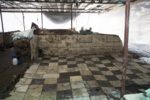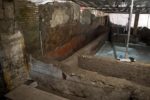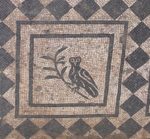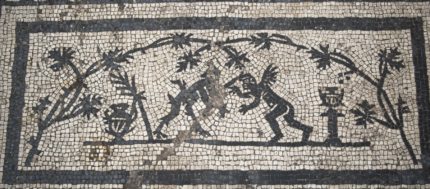 Archaeologists have unearthed the large, luxuriously appointed 2nd century domus of a Hadrianic military commander at the Amba Aradam station on Rome’s future Metro C line. This is the same site where the military barracks were discovered in 2016, and in fact the villa is connected to the barracks dormitory via a corridor with a staircase. The villa was found 12 meters (40 feet) below the surface, three meters beneath the barracks. This is the first villa of a military commander ever discovered in Rome.
Archaeologists have unearthed the large, luxuriously appointed 2nd century domus of a Hadrianic military commander at the Amba Aradam station on Rome’s future Metro C line. This is the same site where the military barracks were discovered in 2016, and in fact the villa is connected to the barracks dormitory via a corridor with a staircase. The villa was found 12 meters (40 feet) below the surface, three meters beneath the barracks. This is the first villa of a military commander ever discovered in Rome.
 The domus is an imposing 300 square meters (3,230 square feet) in area over least 14 rooms. They are lavishly decorated with black and white mosaic floors with floral motifs, animals (a very smart-faced owl among them) and a scene of a satyr and a winged Cupid either fighting or frolicking. The villa also boasts marble tiles in contrasting colors and frescoed walls. One of the rooms was heated, likely a private bath, as evidenced by the telltale piles of bricks under the flooring that allowed the heated air to circulate. As was typical of the Roman villa, the rooms were arranged around the atrium, a square courtyard in the middle of the house in which archaeologists found the remains of a fountain.
The domus is an imposing 300 square meters (3,230 square feet) in area over least 14 rooms. They are lavishly decorated with black and white mosaic floors with floral motifs, animals (a very smart-faced owl among them) and a scene of a satyr and a winged Cupid either fighting or frolicking. The villa also boasts marble tiles in contrasting colors and frescoed walls. One of the rooms was heated, likely a private bath, as evidenced by the telltale piles of bricks under the flooring that allowed the heated air to circulate. As was typical of the Roman villa, the rooms were arranged around the atrium, a square courtyard in the middle of the house in which archaeologists found the remains of a fountain.
 On the other side of the barracks is another structure built later than the barracks and commander’s house. Replete with brick pavements, water conduits and tubs, the building appears to have been a service area where supplies were stored and kept as cool as possible. There archaeologists also discovered surviving wood objects, mainly construction tools like the forms used to build the foundations and discarded carpenter’s beams. The team has also found everyday use objects, gold rings, the carved ivory handle of a dagger, amulets and bullae that have helped archaeologists create a timeline of the remains and identify numerous reconstructions of the compound over the years.
On the other side of the barracks is another structure built later than the barracks and commander’s house. Replete with brick pavements, water conduits and tubs, the building appears to have been a service area where supplies were stored and kept as cool as possible. There archaeologists also discovered surviving wood objects, mainly construction tools like the forms used to build the foundations and discarded carpenter’s beams. The team has also found everyday use objects, gold rings, the carved ivory handle of a dagger, amulets and bullae that have helped archaeologists create a timeline of the remains and identify numerous reconstructions of the compound over the years.
 Like the barracks, the domus and service area were abandoned and, the second half of the 3rd century, they were destroyed, their walls cut down to four-foot stumps. This likely took place in 271 A.D. when the Aurelian Walls were being fortified and anything outside of the perimeter that could provide refuge and access to the enemy was demolished.
Like the barracks, the domus and service area were abandoned and, the second half of the 3rd century, they were destroyed, their walls cut down to four-foot stumps. This likely took place in 271 A.D. when the Aurelian Walls were being fortified and anything outside of the perimeter that could provide refuge and access to the enemy was demolished.
The black and white mosaics, marble floors, fountain and frescoed walls that remain are too fragile to be left in situ while the new station is built underneath it. Therefore the entire site be dismantled, moved to a temporary location and then returned to their original location.

You can see some excellent footage of the excavators at work and of the villa in this video:
The mosaics are fascinating.
Th owl mosaic is titled “Owl Friend”. Why “friend”, didn’t the ancient Romans think the owl as being an evil omen, a predictor of death? I recall Virgil mentioned that in the Aeneid.
The “Satyr/Cupid Fight” mosaic seems similar to the Christian story of the Archangel Michael fighting a cloven hoofed devil. Is there linkage between the Greek God Pan and the concept of the Christian Satan?
Wrong video
I sure would love to live in a place where putting a shovel in the ground reveals treasures. Those mosaics!
Living in a place like that is not always being in the Garden of Eden
Unless one lives on a snowfield, most shovel in the ground activities reveals treasure – but mostly we do not recognise that treasure 😉